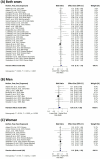Dose-response relationship of cadmium and pancreatic cancer risk: a meta-analysis
- PMID: 40962531
- PMCID: PMC12573421
- DOI: 10.1136/oemed-2025-110163
Dose-response relationship of cadmium and pancreatic cancer risk: a meta-analysis
Abstract
Cadmium (Cd), a group 1 carcinogen, is linked to the development of pancreatic cancer. Not well-defined is the dose-response relationship between Cd and cancer development.This study investigated the relationship between Cd exposure and the risk of pancreatic cancer through a meta-analysis focusing on pooled relative risk (RR), biomarker comparisons and dose-response relationships.This meta-analysis adhered to PRISMA (Preferred Reporting Items for Systematic Reviews and Meta-Analyses) guidelines and applied the PECO (population, exposure, comparator and outcomes) framework. Systematic searches of key databases, including PubMed, Cochrane Library, Web of Science, EMBASE, ScienceDirect and ProQuest, were carried out without language restrictions. Studies that met the predefined PECO criteria were chosen, extracting data on effect estimates such as HRs, ORs, RRs and Cd biomarker concentrations. Analyses involved pooled RRs, standardised mean differences for biomarker comparisons and dose-response relationships, using random-effects meta-analysis and meta-regression. Statistical procedures were performed on R V.4.3.0.Cd exposure was significantly associated with an increased risk of pancreatic cancer, with a pooled RR of 1.42 (95% CI=1.16 to 1.73). Subgroup analyses confirmed this association in both occupationally and non-occupationally exposed individuals. Dose-response analyses further revealed that higher Cd biomarker levels correlated with greater pancreatic cancer risk (lnRR coefficient=0.610, p=0.035).Cd exposure is associated with an increased risk of pancreatic cancer, with a dose-response relationship and elevated biomarker levels in cases. Cd exposure is a modifiable risk factor for pancreatic cancer, meriting further investigation.
Keywords: Cadmium; Gastroenterology; Meta-analysis; Occupational Health; Public health.
© Author(s) (or their employer(s)) 2025. Re-use permitted under CC BY. Published by BMJ Group.
Conflict of interest statement
Competing interests: None declared.
Figures



References
-
- Pourshams A, Sepanlou SG, Ikuta KS, et al. The global, regional, and national burden of pancreatic cancer and its attributable risk factors in 195 countries and territories, 1990–2017: a systematic analysis for the Global Burden of Disease Study 2017. Lancet Gastroenterol Hepatol. 2019;4:934–47. doi: 10.1016/S2468-1253(19)30347-4. - DOI - PMC - PubMed
Publication types
MeSH terms
Substances
LinkOut - more resources
Full Text Sources
Medical
Miscellaneous
